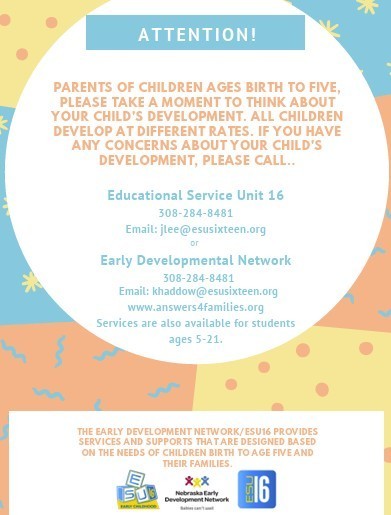Identifying Developmental Needs Early
Children develop at different rates, but recognizing when additional support may be needed is crucial. The Child Find Screening Program, coordinated by local school districts in partnership with Educational Service Unit 16 (ESU 16), provides families with opportunities to assess their child’s development from birth to age five.
Parents are encouraged to observe developmental milestones in areas such as speech, motor skills, social interactions, and learning. For example, by age three, most children should be using 3–4 word sentences, be understood by others at least 75% of the time, and begin separating easily from a parent. By age four, children should be able to answer questions, hop on one foot, and use descriptive words like “big” and “small.” If delays are observed, families can request a free evaluation at home or in the local schoolChildfind-Parents letter.
Early Development Network Services
The Nebraska Early Development Network (EDN) ensures that services are available for children birth through age five at no cost to families. The program is family-centered, tailoring services to meet individual needs. Parents concerned about delays—such as difficulty talking, walking, feeding, or behavior challenges—can call 308-284-8481 or the Nebraska Child Find hotline (1-888-806-6287) for referrals
These services also extend beyond age five, with support available for students up to age 21 through ESU 16, addressing speech/language, motor development, social/emotional needs, and learning differences
Articulation and Speech Development
A Sound Chart from ESU 16 illustrates when children typically master different consonant sounds in English. Research shows that most children acquire early sounds like p, b, m, n, d, and h by ages 3–4, while later sounds such as r, voiced/voiceless “th,” and “zh” are not fully mastered until ages 6–7. This chart helps parents and educators determine whether a child’s speech development is progressing within expected timelines
Community Awareness and Communication
On October 3, 2025, ESU 16 issued a media release announcing fall Child Find screenings across local school districts. These screenings allow professionals to answer parent questions about preschoolers’ development. Families with older children (ages 5–21) can also be referred to Student Assistance Teams, who provide accommodations or recommend further evaluations
A related school district communication emphasized the importance of distributing information consistently throughout the year. Schools were provided with brochures, fliers, and letters to parents to ensure awareness, while daycares, preschools, and churches also receive updated materials. This effort addresses the misconception that screening is only offered at limited times, reminding families that evaluations are available year-round.
School District Updates – Fall 2025
In addition to developmental services, the School District Fall 2025 plan outlines broader commitments to supporting student learning and growth. This includes ensuring that families are aware of programs like Child Find and EDN, while also fostering collaboration between parents, schools, and community partners.
Conclusion
The combined resources from Child Find, ESU 16, and the Early Development Network highlight a strong community commitment to helping children thrive. By monitoring milestones, providing free screenings, and connecting families to services, schools and families can work together to ensure that every child has the opportunity to reach their full potential.
For questions or referrals, parents are encouraged to contact ESU 16 at (308) 284-8481 or Nebraska Child Find at 1-888-806-6287.

